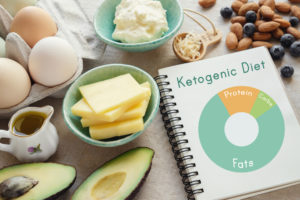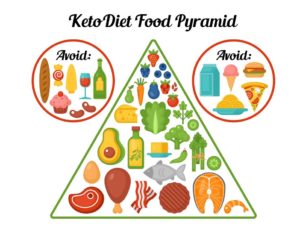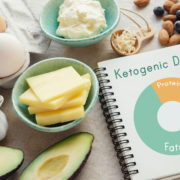‘What is a Keto Diet’…and what are its Pros and Cons?
 If you’re asking ‘what is a keto diet’, we feel your curiosity. It’s not exactly self-explanatory in name. And although it’s an abbreviation for ‘ketogenic diet’, that’s not too helpful in providing hints of the details either.
If you’re asking ‘what is a keto diet’, we feel your curiosity. It’s not exactly self-explanatory in name. And although it’s an abbreviation for ‘ketogenic diet’, that’s not too helpful in providing hints of the details either.
In this article, we’ll look at the basics of what a keto diet is and weigh its pros and cons. We’ll look at it objectively as neither proponents nor opponents of the method. By reading it, you’ll gain the information necessary for deciding whether the Ketogenic Diet method of fat loss is ideal or even suitable for you.
‘Ketones’ for Body Fuel
The keto diet is all about reducing carbohydrate intake to such rock bottom levels that the body shifts to using ‘ketones’ for energy. Ketones are chemicals made in the liver from fat. They’re triggered into production when glucose and insulin get very low. Ketones can be used as fuel by the brain, muscles, and other tissues when the body’s preferred energy source (carbohydrate) is too low.
The keto diet calls for macro-nutrient ratios of at least 70% of daily calories coming from fat along with 20% from protein. That leaves no more than 10% of calories supplied by carbohydrates. This results in low enough carb levels so as to trigger the body’s burning of fat for fuel (ketosis).
It typically takes the body about 3 to 7 days to adjust to this. Until then, adherents describe symptoms often referred to as the “keto flu” which includes fatigue, nausea, dizziness, insomnia, upset stomach, dehydration, bad breath, and difficulty concentrating.
So what is the keto diet if not without its share of controversy?
The purported benefits of this extreme diet are stabilized blood sugar, reined-in carb cravings, increased satiety, and even an eventual improved ability to focus. Some proponents even claim the keto diet can solve a range of problems like heart disease, cancer, diabetes, and autism. This idea could have merit given the diet’s call for reducing or eliminating many pro-inflammatory foods.
So, will you lose body fat by being in “ketosis?”
Most likely, you will. The initial weight loss would probably be water weight. When carbohydrates are stored in the body, they carry a lot of water with them. By suddenly slashing carb intake down to just 10% of daily calories, a few pounds of water will flush out. But over time, the remaining weight loss will likely be from body fat reduction as this eating method naturally cuts calorie intake.
How You’d Eat on a Keto Diet
If you were to adopt a keto diet, your shopping list should include lots of foods containing high quality protein and healthy fats. Think along the lines of lean grass-fed cow beef, chicken thighs/breasts, eggs, and unsweetened full-fat yogurt as good protein sources. For fat intake, think of olive oil, coconut oil, palm oil, raw almonds, and grass-fed cow butter as good sources.
You’d obviously avoid processed and sugary foods on a keto diet. But in addition, you’d avoid grains, beans, legumes, light dairy, most fruits, and starchy vegetables.
To put the macro breakdown in perspective, imagine a 2,000 calorie-per-day diet. Since there are 9 calories in each gram of dietary fat, you’d cover 1,400 of those calories with 156 grams of fat (156 x 9 = 1,404).
Recalling that there are four calories per gram of protein and carbs (respectively), the remaining 600 calories of energy would be split between them with protein taking the bulk.
Let’s say you’re a 200-pound man with 25% body fat (that’s high, I know). This makes it simple; you’d have 150 pounds of lean mass. If you were to shoot for .9 grams of protein per pound of lean body mass, you’d need 135 grams of protein per day (150 x .9 = 135). That would cover another 540 daily calories with protein intake (135 x 4 = 540).
Now you’d have just sixty calories you can fill with carbohydrates. That’s equivalent to about a single slice of rye bread. If you could stick with such an extreme diet, you’d almost certainly reduce that 25% body fat level.
But the question becomes whether you’d be able to sustain such a stringent eating plan over the long run.
Keto Diet: The Pros
Let’s take a look at the favorable aspects of this eating plan…
- High fat intake (in place of carbohydrates) creates a feeling of satiety, making it easier to reduce daily calorie intake without cravings.
- The body becomes more efficient at burning body fat. By stripping away carb intake, the body is forced to become better at burning fat as fuel.
- It could reduce bodily inflammation. By requiring adherents to slash carbohydrates from their diets, a lot of pro-inflammatory junk food goes out the window. That’s a good thing.
- It ‘resets’ insulin sensitivity. The body’s cells become resistant to insulin due to out-of-control long-term carb binging. A keto diet, with its near elimination of carbohydrates, could correct this metabolic problem.
- It can specifically lower ‘visceral’ fat. Research shows that low carb diets tend to reduce fat surrounding the organs of the abdominal area – a particularly hazardous type of body fat.
Keto Diet: The Cons
Let’s take a look at the not-so-favorable aspects of this eating plan…
- Adjusting to a keto diet is often unpleasant. Since the brain is accustomed to using glucose as fuel, a sudden switch to ‘fat-as-fuel’ likely won’t sit well with it. Adherents to the diet often report brain fog, dizziness, headaches, and “bad moods” as initial side effects.
- It can lead to a quick plateau. As with all low-carb diets, the first two weeks result in big weight loss due to the flushing of water and glycogen. This can result in a ‘false positive’ as the actual shedding of body fat can be a relatively slow process thereafter.
- It doesn’t go well with athletics. If you’re an athlete, bodybuilder, power-lifter, or just a very active person, you might want to steer clear. Some research has shown that going this low in carbs will negatively affect physical performance.
- It might be a wild card in terms of affecting a person’s cardio system. Raising dietary fats to these levels could wreak havoc on one’s lipid profile. Granted, much of this fat will be converted to glucose to be used as fuel. But it’s speculative as to whether an adherent’s lipid profile will land in a healthful place. Monitoring of it would be essential.
- Bad breath is a common side effect. All those ketones in the blood result in acetone being released with each exhale. Friends and family members might describe your breath as smelling like nail polish remover.
Keto Diet Conclusions
The keto diet falls under a “carbs are evil” category of eating plan for which a handful of other currently popular diets fall. These plans remain popular as they fulfill the human desire for immediate positive reinforcement. Since many people equate ‘weight loss’ with fat loss, the immediate drop in water weight spurred by low carbohydrate intake results in a quick conclusion that the diet is “working.”
Of course, fat loss can come from long term adherence to a keto diet. But the degree to which it’s due to “burning fat as fuel” as opposed to mere calorie restriction naturally arising from the measurement of macro-nutrient intake is open to debate. “Going Keto” results in a dieter becoming ‘controlled’ in their calorie intake, even if that control is a simple offshoot of measuring an extreme shift in macronutrient balance.
Whether a keto diet is right for you depends on results of your weighing its pros against its cons. In addition, it depends on your long-term goals and how long you realistically think you can nearly ban all traces of carbs from your life.
If you’re like a lot of people and don’t think that’s realistic, you’re probably better off avoiding the keto diet. Either that or have a modified, less restrictive diet planned as a fall-back after you’ve used a Keto Diet to shed fat and improve insulin sensitivity.


